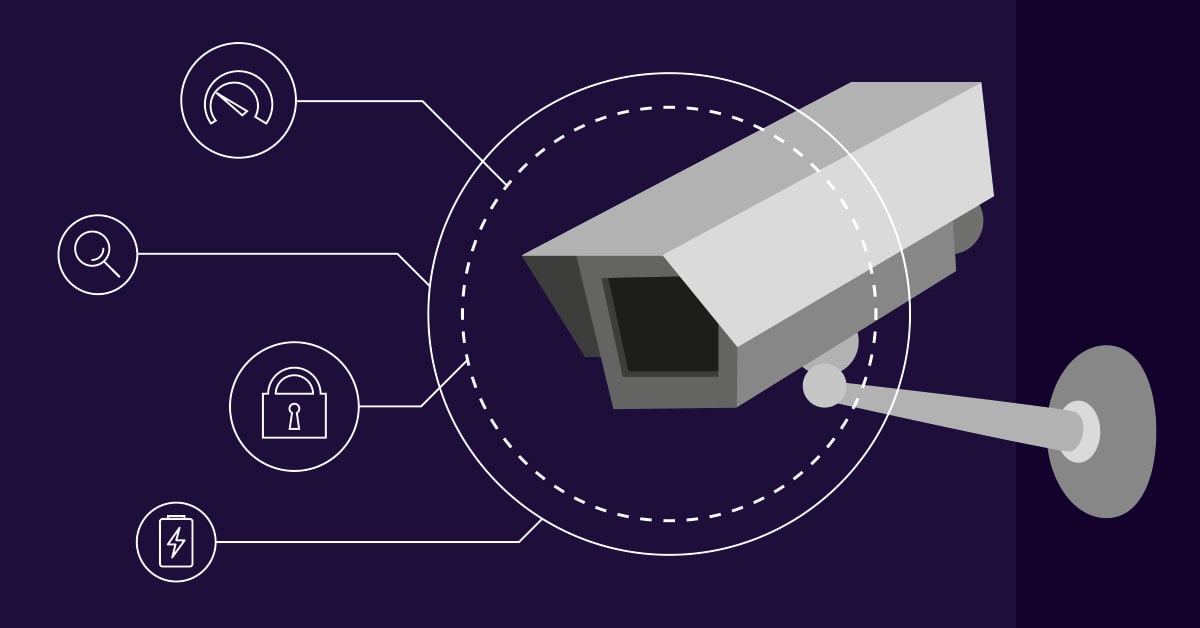The basic principles of physical security have been around for decades and have not changed that much: surveillance, intrusion detection, and triggering alarms in case of breaches or anomalies still form the basis of any security installation. What has changed is the technology driving these basic principles, as digitization has changed the very bones of physical security systems.
Along with this digitization, new cybersecurity challenges and network vulnerabilities have arisen. In this post, we take a look at some of these challenges and how to mitigate them with effective physical security monitoring.
Digitized Physical Security Systems
But what are these new technologies ("new" being relative, considering some have been around for more than a decade) that are changing the physical security industry? Here are some key components and examples:
- IP Cameras: In the late '90s, the first network cameras kickstarted the move in video surveillance away from analogue and towards digital. Later, IP cameras, which embraced IP networking technology, Power over Ethernet (PoE), and various kinds of video compression, provided a better way to connect and manage surveillance cameras and CCTV camera systems.
As an added bonus, it has become easier to access video feeds remotely using mobile devices, which supports real time video security and detection of suspicious activity. - IP Access Control: Not only cameras took advantage of IP networking technology. IP access controllers and access control systems can connect directly to the network and no longer need a terminal server as they did in the old days.Modern access control uses authentication mechanisms like keycards or PINs and sometimes biometric identifiers to protect secure areas and prevent unauthorized access and unauthorized entry at critical entry points.
- Digital Data Storage: Previously, data such as recorded video footage was committed to tape. More recently, data is stored digitally on hard drives or in the cloud.
This does not only include video surveillance, but also logs and configuration data that might contain sensitive information related to security controls and security policy.
The shift to digital storage creates new monitoring requirements. Network attached storage (NAS) devices, video management servers, and cloud connectivity all require continuous oversight. Storage capacity monitoring becomes critical, because running out of disk space during a security incident or break in could have serious consequences for incident investigation, risk assessment, and compliance with internal physical security plans or external security standards.
- Other "Things": In the age of IoT, many other devices are network-enabled. Panic buttons, motion sensors, intercom systems, HVAC (Heating, Ventilation, and Air Conditioning) systems, and smoke detectors are just a few examples. These are detection systems that contribute to perimeter security, intrusion detection, emergency response, and the protection of sensitive areas.
A Smorgasbord of Physical Security Technologies
Smorgasbord (thanks, Sweden!) is an apt description for modern physical security systems. Because of the digitization of their components, these systems are often a patchwork of physical security technologies, protocols, and a variety of devices from multiple vendors. Physical security solutions can include surveillance systems, camera systems, access control devices, license plate recognition, video analytics software, and building automation.
The first challenge security system integrators face is that they need to get all these disparate devices on a network, and then get that network configured and optimized in a scalable and cost effective way. This has to include basic functionality, physical security measures like physical barriers, and the right security controls for critical entry points and sensitive areas.
But getting the environment set up and configured is just the first part of the struggle.
The second challenge is maintaining visibility into system health once everything is operational. A camera that appears functional might actually be consuming excessive bandwidth, indicating a hardware issue that could lead to failure or gaps in surveillance coverage. Storage systems might be approaching capacity limits without obvious warning signs. These "silent failures" are often more dangerous than obvious outages because they create false confidence in system reliability and increase physical security risk.
Real time physical security monitoring helps security teams and security personnel identify these potential threats before they turn into full security breaches, criminal activity, or vandalism.
The New Weakest Link: The Network
The digitized nature of modern physical security systems introduces new points of failure in addition to the traditional ones. For example, lost data has become a factor. With video data stored digitally, if something goes wrong, such as a storage device crashing or the network not transmitting data, video footage can be lost. This affects video surveillance, post incident analysis, and even cooperation with law enforcement after a serious incident.
But perhaps the biggest weak point for modern physical security systems is the underlying network. Bottlenecks, bandwidth monitoring issues, or routing problems that prevent data being sent or received properly are all things that can compromise a security plan and reduce the effectiveness of physical security measures on site.
And if cyber criminals get access to the network or devices, they have the ability to negate the security of the entire system. This might involve shutting down aspects of the system, disabling detection systems or camera systems, or using devices for purposes other than intended. In this context, physical security and cybersecurity are tightly linked, and network vulnerabilities can quickly turn into physical security threats.
The above risks pose a critical danger to any security installation. So how do you prevent these things from happening?
The short answer is: you cannot completely circumvent these risks. Electronic devices will malfunction, networks will have bandwidth issues, and storage devices will fail. These are the eternal truths of the digital world. All you can do is take preventative steps where possible, perform regular risk assessment, and set up alerts and notifications for when there is a failure or a deviation from normal behavior. Enter comprehensive network monitoring as one of the key security tools for security operations.
Monitoring the Security System
As with other industries, modern physical security systems have seen a convergence with traditional IT. You have specialized security devices running on the same infrastructure as operational IT devices such as switches, servers, routers, and wireless controllers. While this does add to the complexity of these systems, it also means that there is the possibility to monitor everything in one place, despite the disparate technologies and vendor ecosystems.
Modern network monitoring platforms like PRTG Network Monitor excel in these mixed environments because they offer many sensor types that can be used for security infrastructure alongside traditional IT monitoring capabilities. This unified approach allows security teams to monitor everything from IP camera bandwidth and availability to UPS monitoring and network device health using the same dashboard and alerting system, with real time notifications when thresholds are exceeded.
The same general steps that apply to monitoring traditional IT environments also apply to monitoring a physical security system network:
- Establish the metrics for a healthy running system. For example:
- How much bandwidth do specific surveillance cameras or camera systems use when operating normally?
- What does the traffic flow look like in different parts of the network at different times of day, including perimeter security zones and access control panels at main entry points?
- What kind of CPU usage is normal for servers running video management, video analytics, or access control software?
- What are the typical response times for access control authentication requests, such as keycard or biometric checks?
- How much storage capacity is consumed daily by video recordings and other sensitive information?
- What network latency is acceptable for real time security alerts, intercom calls, or emergency response notifications?
- Based on the metrics from step 1, set up thresholds and alerts. When values go above or below the "normal" values, then you know that you have a potential problem, such as an emerging physical security risk, unauthorized access attempts, or a misconfigured device that might impact functionality during a critical event
Using a good network monitoring solution, it is possible to get a view of the entire network on one dashboard. Furthermore, the information you get from monitoring the network can help you make adjustments to help prevent loss of data, physical security breaches, or critical failures during an incident. Take a look at some examples in the table below of potential issues you can pick up when monitoring a physical security system.
Examples of issues and possible resolutions:
| Technology | Issue | Potential impact on physical security systems | Possible resolution |
|---|---|---|---|
| IP cameras / CCTV | High bandwidth usage | Video surveillance gaps, delayed video security feeds, missed suspicious activity | Adjust image resolution, video compression, or frame rate. Optimize camera placement and network paths. |
| Storage devices | Low disk space available | Loss of recorded footage and other sensitive information during a break in or vandalism | Archive older data, or increase HDD/NAS size. Define retention policies aligned with security policy. |
| UPS and power | Low UPS battery level or faulty UPS | Loss of surveillance systems, access control, and detection systems during power outage | Investigate reasons for the low level, and replace or repair if necessary. Test failover procedures regularly. |
| Access control | Controller offline or slow authentication | Unauthorized entry opportunities, blocked secure areas, failed authentication at entry points | Monitor controller health and network connectivity. Investigate door controllers, keycard readers, and biometric devices. |
| All IP devices | Device not responding | Reduced deterrence and higher physical security risk due to blind spots or offline systems | Troubleshoot the issue, check power and network connections, and restore functionality as fast as possible. |
| Network infrastructure | Switch or router failures affecting camera feeds or access control | Loss of perimeter security visibility, missed detection of suspicious activity or criminal activity | Monitor network device health with SNMP sensors to prevent connectivity loss, and design redundancy where possible. |
Monitoring physical security environments with PRTG Network Monitor
One of the advantages of network monitoring is that the kinds of systems you can monitor are quite varied, as long as the connected devices offer standard technologies such as SNMP, NetFlow, WMI, and HTTP APIs. PRTG Network Monitor supports over 250 sensor types, which makes it effective for the diverse device ecosystem found in modern physical security installations that combine IT and OT components.
While the monitoring approach remains the same, which is to configure a sensor for a device and get statistics from that sensor, the actual network can look very different from one installation to another. So with the same network monitoring principle, you might be monitoring a hospital, a Smart Home, a Smart City, or a complex physical security system.
Ready to implement comprehensive monitoring for your physical security infrastructure? PRTG Network Monitor helps you monitor the IT backbone that supports your physical security solutions, from IP cameras and video surveillance servers to access control systems and storage platforms. Start your free 30 day trial and see how unified physical security monitoring can strengthen your security operations and support your broader physical security plans.
 Published by
Published by 












